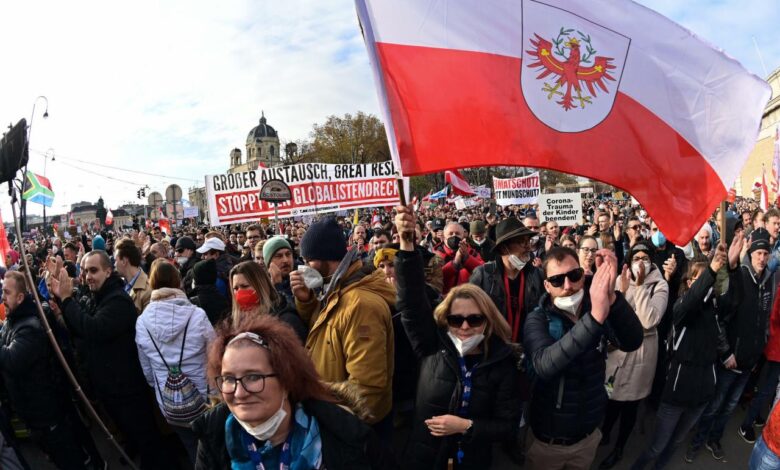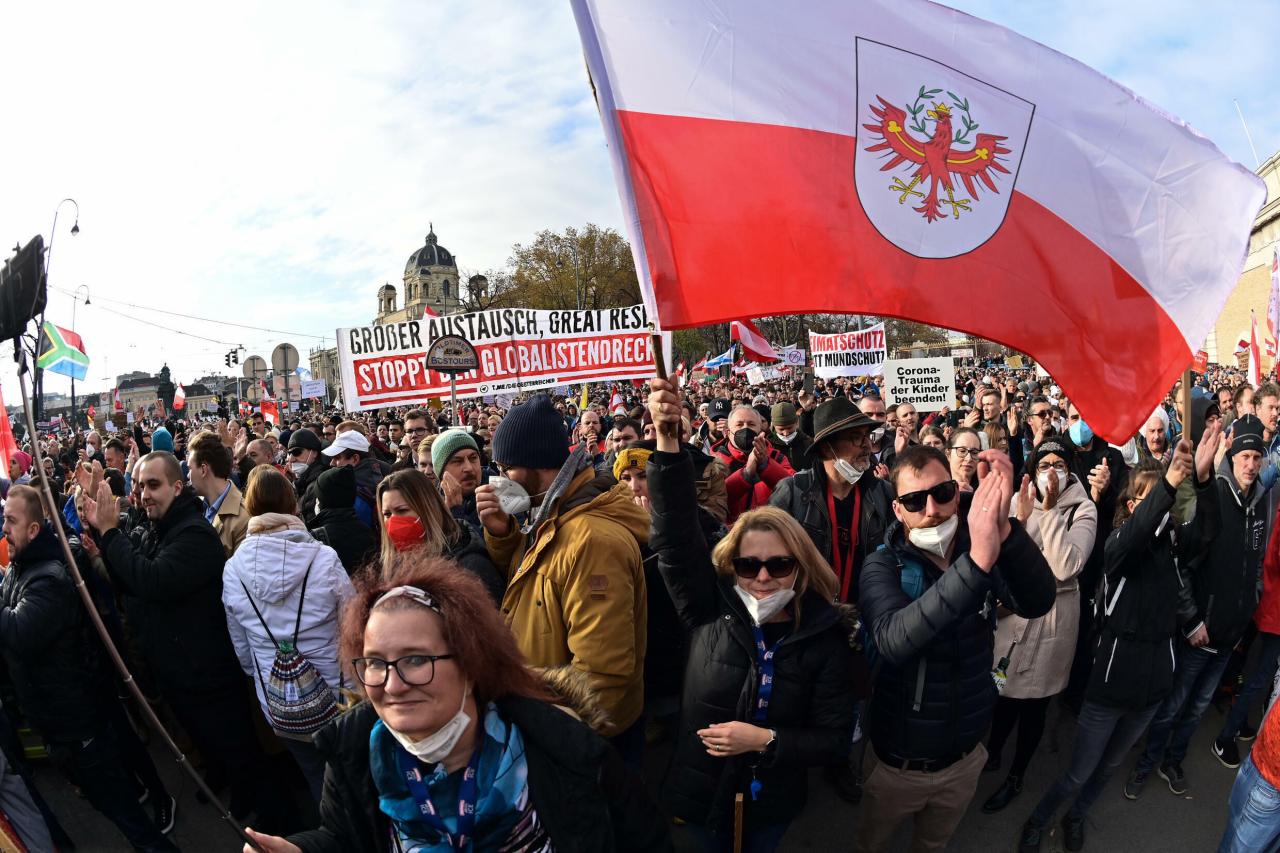
Austria Entering COVID Lockdown Impact and Implications
Austria entering COVID lockdown presents a critical moment, demanding careful consideration of its potential ramifications. This new measure signals a serious escalation in the country’s fight against the virus, with significant implications for the economy, public health, and social life. A historical overview of previous lockdowns, along with an analysis of the current COVID-19 situation in Austria, will be crucial to understanding the potential impacts of this decision.
The potential for a lockdown in Austria highlights the complex interplay between public health concerns and economic realities. This article delves into the factors influencing the decision, the potential impacts on various sectors, and the likely public response. We’ll also compare Austria’s situation to other European countries facing similar challenges, offering insights into the global context of the COVID-19 pandemic.
Background of Austrian COVID-19 Situation
Austria, a nation known for its Alpine beauty and robust economy, has experienced a fluctuating COVID-19 trajectory since the pandemic’s onset. The country’s response has involved various measures, including lockdowns, mask mandates, and vaccination campaigns. Understanding this history provides context for the current situation and the ongoing challenges.The initial wave of COVID-19 in Austria, like many other European nations, saw a rapid increase in cases, leading to significant restrictions.
The country’s early approach involved a combination of containment strategies and public health measures, including lockdowns and social distancing guidelines.
Historical Overview of COVID-19 Cases and Restrictions
Austria’s COVID-19 case numbers and restrictions have evolved over time. The early stages were characterized by a focus on containing the virus, while later phases saw a shift towards managing the pandemic. This evolution reflected changing scientific understanding, public health concerns, and the availability of vaccines.
- Early Stages (2020): Austria’s initial response to the pandemic included strict lockdown measures, including closures of non-essential businesses, limitations on social gatherings, and widespread mask mandates. These measures aimed to limit transmission and protect the healthcare system.
- Vaccination Rollout (2021): The rollout of COVID-19 vaccines in Austria began in early 2021. This marked a significant step in the country’s fight against the pandemic, aiming to build community immunity and reduce the severity of illness.
- Variants and Relaxation (2021-2022): The emergence of new COVID-19 variants, like Delta, led to renewed concerns about transmission. Austria, like other countries, adjusted its restrictions in response to these variants. Subsequently, there were periods of reduced restrictions as case numbers declined.
- Ongoing Monitoring (2023-present): Austria continues to monitor COVID-19 cases and adapt its measures to changing circumstances. This includes surveillance of variants, vaccination efforts, and ongoing public health recommendations.
Current COVID-19 Situation in Austria
The current situation in Austria reflects the ongoing impact of the pandemic. The evolving nature of the virus, coupled with public health measures and individual choices, continues to influence the nation’s experience.
- Case Numbers: Austria’s current COVID-19 case numbers are tracked and reported regularly by the Austrian Ministry of Health. These figures provide insight into the spread of the virus within the population.
- Hospitalizations: The number of COVID-19 patients requiring hospitalization in Austria is a key indicator of the pandemic’s severity. Hospitalization rates are tracked to assess the strain on the healthcare system.
- Vaccination Rates: Vaccination rates in Austria are a crucial factor in mitigating the impact of the virus. Vaccination rates are monitored to gauge the level of community immunity.
Previous Lockdowns and Their Impact
Austria’s previous lockdowns had a significant impact on the country’s economy and society. These measures, while intended to control the spread of the virus, resulted in various economic and social consequences.
- Economic Impact: Lockdowns led to business closures, reduced consumer spending, and job losses. The impact varied across different sectors, with some industries experiencing greater disruptions than others.
- Social Impact: Lockdowns restricted social interactions and created stress for many individuals. The impact on mental health and well-being was a significant concern, especially for those who were isolated or experienced financial hardship.
Timeline of Key Events Related to COVID-19 in Austria
A timeline of key events provides a comprehensive overview of the pandemic’s progression in Austria. This chronological account demonstrates the evolving nature of the virus and the country’s responses.
| Date | Event |
|---|---|
| 2020-March | Initial Lockdown |
| 2021-January | Vaccine Rollout Begins |
| 2021-July | Delta Variant Surge |
| 2022-April | Relaxation of Restrictions |
Reasons for Potential Lockdown
Austria’s recent COVID-19 trajectory has prompted careful consideration of potential lockdown measures. The country, while having seen a relative decrease in case numbers in recent weeks, faces the ongoing threat of new variants and the potential for a resurgence. Understanding the factors that could trigger a lockdown is crucial for navigating this evolving public health landscape.Potential factors contributing to Austria considering a lockdown include a variety of interconnected elements.
Rising case numbers, coupled with the strain they place on the healthcare system, are key considerations. The impact of new and potentially more contagious variants on infection rates is another important factor.
Potential Triggers for Lockdown
Several factors could lead to a decision for a lockdown in Austria. These are not mutually exclusive; rather, a combination of factors could trigger a resurgence and the need for restrictive measures. Rising case numbers, particularly if they increase at an alarming rate, are a primary concern. A rapid surge in hospitalizations, straining the healthcare system’s capacity to treat critically ill patients, would necessitate immediate action.
The emergence of new, more transmissible variants, or the re-emergence of variants with increased virulence, would significantly alter the risk assessment.
Economic and Social Considerations
Lockdowns have significant economic and social repercussions. Reduced economic activity due to business closures and restrictions on movement impact employment and consumer spending. The psychological toll of isolation and social restrictions on individuals and communities should not be underestimated. Government support measures, such as financial aid and social safety nets, are critical to mitigate these negative consequences.
The Austrian government’s experience with previous lockdowns, and the subsequent adjustments and support programs, provide a valuable context for assessing the potential impact.
Comparison with Other European Countries
The COVID-19 situation in Austria is not isolated; other European countries face similar challenges. Monitoring the experiences of neighboring countries, such as Germany, France, and Italy, offers insights into the efficacy of different strategies and the impact of various factors on infection rates. Observing the effectiveness of different lockdown strategies in these countries provides valuable context for the Austrian government’s decision-making process.
Austria’s latest COVID lockdown has got me thinking about office supplies. With everyone shifting to remote work, keeping track of your packaging and shipping costs is crucial. Managing those expenses effectively is key to navigating this situation, and staying on top of your office packaging shipping supplies costs can help you stay afloat. It’s a good reminder that even in a lockdown, efficient supply management can make a big difference.
For example, a comparison of the different approaches to mask mandates, vaccination campaigns, and economic support programs across these countries provides valuable insights into the optimal approach to mitigate the spread of COVID-19. Austria’s approach will need to consider factors unique to its social and economic fabric, and not simply emulate other countries’ policies.
Potential Impacts of a Lockdown

A lockdown, while a necessary measure to curb the spread of COVID-19, carries significant economic and social consequences. The Austrian economy, heavily reliant on tourism and hospitality, faces a considerable challenge in weathering such a period of restricted activity. Understanding these potential impacts is crucial for policymakers and citizens alike to prepare for the realities of a lockdown and mitigate its negative effects.
Economic Repercussions
Austria’s economy, like many developed nations, is intertwined with various sectors. A lockdown will undoubtedly lead to reduced economic activity across the board. Businesses will experience decreased revenue, potentially leading to job losses and reduced investment. The interconnectedness of the Austrian economy means that a downturn in one sector will often ripple through others.
Impact on Tourism and Hospitality
The tourism and hospitality sectors are particularly vulnerable to lockdowns. Hotels, restaurants, and other businesses reliant on visitor traffic will suffer significant revenue losses. The cancellation of bookings, the halt of tourist activities, and the reduction of international travel will severely impact their operations. Many businesses in these sectors operate on thin margins, making them highly susceptible to even short-term disruptions.
This could result in temporary closures, reduced staff, and a prolonged period of recovery.
Impact on Retail
Retail businesses will also face challenges. Reduced foot traffic and potential consumer spending cuts will impact sales. Stores that rely on in-person shopping will be especially affected. Online sales might increase temporarily, but this will not fully compensate for the lost in-store revenue.
Impact on Other Sectors
Lockdowns affect other sectors too. The construction industry will see reduced activity due to limitations on worksite access. The manufacturing sector will face challenges from supply chain disruptions and reduced demand. The transportation sector, including airlines and public transport, will be severely affected by reduced travel.
Social and Psychological Effects
Beyond the economic ramifications, lockdowns have significant social and psychological implications. Isolation and confinement can lead to feelings of loneliness, anxiety, and depression. Restrictions on social interaction and activities can have a profound impact on mental health, especially for vulnerable populations. Increased stress and mental health concerns could also impact productivity and well-being in the long term.
Potential Financial Losses
| Sector | Potential Loss Estimate (in millions of Euros) | Explanation |
|---|---|---|
| Tourism | €100-150 | Based on historical data and anticipated reduction in tourist arrivals and spending. |
| Hospitality | €80-120 | Estimates based on past lockdowns and expected decrease in restaurant and bar operations. |
| Retail | €50-75 | Projected losses based on decreased foot traffic and reduced sales during closure periods. |
| Construction | €30-45 | Estimate based on reduced worksite access and project delays. |
| Manufacturing | €20-30 | Projected loss considering supply chain disruptions and reduced demand. |
Note: These are estimates, and the actual financial losses may vary depending on the duration and stringency of the lockdown measures. Real-world examples from past lockdowns in other countries can provide valuable insights, but specific circumstances and economic factors will influence the outcomes.
Austria’s recent COVID lockdown has got me thinking about travel disruptions. It’s a stark reminder of how quickly things can change, especially in the travel industry. Similar to how agents are now redirecting babymooners to other destinations as Zika spreads, agents redirect babymooners as Zika spreads , this highlights the need for flexibility and adaptability when planning trips, especially during a pandemic.
The current situation in Austria serves as a strong example of how these kinds of unforeseen circumstances can quickly impact travel plans.
Public Response and Reactions: Austria Entering Covid Lockdown
Austrian citizens’ response to COVID-19 lockdowns has varied throughout the pandemic, influenced by factors like government communication, economic impacts, and individual health concerns. Predicting the exact public response to a potential future lockdown requires careful consideration of these factors. Past reactions offer valuable insights, but each situation is unique and dependent on specific circumstances.Understanding the likely public response to a potential lockdown in Austria is crucial for policymakers.
Public opinion will significantly impact the effectiveness and longevity of any measures. This analysis examines potential public reactions, drawing upon previous experiences and considering the broader European context.
Potential Public Reactions to a Lockdown
The public response to a lockdown will likely depend on several factors. Public trust in the government’s handling of the crisis will be a significant determinant. Transparency and clear communication about the rationale for the lockdown, its duration, and the support measures in place will be critical. Economic concerns, including job security and financial strain, are also expected to influence public sentiment.
Concerns about the impact on daily life, social activities, and personal freedoms are also significant factors to consider.
Examples of Public Reactions to Previous Lockdowns in Austria
Initial responses to the first Austrian lockdowns were often characterized by compliance, with citizens adhering to restrictions. However, public sentiment began to shift as lockdowns extended. Public frustration, especially regarding economic hardship and the impact on personal freedoms, emerged as the pandemic progressed. This was not unique to Austria; similar patterns were observed across Europe. Anecdotal evidence suggests that social gatherings and protests, albeit smaller in scale compared to other European nations, did occur in Austria.
Potential for Protests or Demonstrations
The possibility of protests or demonstrations cannot be ignored. Historically, public dissent to restrictive measures has been observed in various countries, including Austria. The specific nature and scale of any protests will depend on the severity of the lockdown, the government’s communication strategy, and the economic support measures in place. Previous instances of public opposition to lockdown measures have highlighted the importance of proactively addressing public concerns.
Comparison of Public Opinions on Lockdowns in Austria and Other European Countries
| Country | Public Opinion on Lockdowns (General Sentiment) | Factors Influencing Public Opinion |
|---|---|---|
| Austria | Initially compliant, later mixed with increasing frustration regarding economic hardship and personal restrictions. | Government communication, economic support, perceived necessity of measures, and individual health concerns. |
| Germany | Generally compliant, with a notable segment expressing concern about the economic impact and personal freedoms. | Similar to Austria, with an emphasis on the perceived necessity of the measures and the efficacy of the economic support packages. |
| France | More diverse responses, with significant public dissatisfaction, especially during prolonged lockdowns. | Political divisions, economic strain, and differing perspectives on the effectiveness of the lockdown measures. |
| Italy | Initially compliant, but public frustration grew over time. The impact of the lockdown on the country’s economy was significant. | Economic consequences, healthcare strain, and public trust in the government’s response. |
This table provides a basic comparison; more nuanced data from surveys and polls could offer more precise insights into public opinion. Differences in public responses can be attributed to varying cultural contexts, political landscapes, and economic situations in each country.
Government Actions and Policies
Austria’s response to potential COVID-19 lockdowns will likely encompass a multifaceted approach, balancing public health needs with economic considerations. The government will prioritize mitigating the virus’s spread while providing support to affected businesses and individuals. This includes a comprehensive set of measures, from restrictions on social gatherings to financial aid programs. The communication strategy will play a crucial role in ensuring public understanding and compliance.
Potential Lockdown Measures
The Austrian government’s lockdown measures will likely mirror those implemented in previous waves, focusing on restrictions on movement and social interaction. These measures will likely include limitations on non-essential travel, closures of public venues, and restrictions on social gatherings. The severity and duration of these measures will depend on the evolving epidemiological situation and the level of community transmission.
Past experiences suggest that these restrictions are tailored to specific regions or areas experiencing higher transmission rates, aiming for a targeted approach rather than a blanket lockdown.
Austria’s recent COVID lockdown has got me thinking about the ripple effects of global events. It’s fascinating how one thing can impact another, like how the name change at Aker Yards, a significant player in the maritime industry, is seemingly connected to this new lockdown. aker yards name goes away might not seem directly related, but it highlights how various sectors are intertwined and how even seemingly minor shifts can affect larger situations, ultimately impacting Austria’s lockdown efforts.
Support Packages for Businesses and Individuals
The Austrian government will likely provide substantial financial aid to businesses and individuals affected by the lockdown. These support packages may include grants, loans, and tax relief measures. The specifics will depend on the nature and duration of the lockdown. Government support will likely target sectors most affected by the restrictions. Examples include grants for small and medium-sized enterprises (SMEs) to maintain operations and pay salaries, as well as financial aid for employees who have lost their jobs or have reduced working hours.
Government Communication Strategy
Effective communication is essential during a lockdown. The Austrian government will likely employ a multi-channel approach to inform the public about the measures, provide clarifications, and address concerns. This includes regular updates through press conferences, public service announcements, and readily accessible online resources. Transparency and clarity will be crucial to building public trust and encouraging compliance. The government will also use social media platforms to engage directly with citizens and provide information on support packages and frequently asked questions (FAQs).
Government Support Programs and Criteria
| Program Name | Target Group | Support Type | Eligibility Criteria |
|---|---|---|---|
| SME Relief Fund | Small and medium-sized enterprises | Grants, low-interest loans | Demonstrable impact of lockdown, documented business losses, and operational continuity plan. |
| Unemployment Support | Employees who have lost jobs or reduced working hours | Unemployment benefits, wage subsidies | Proof of employment, documentation of job loss or reduced hours due to lockdown measures. |
| Individual Financial Assistance | Low-income households and vulnerable individuals | Cash grants, subsidized utilities | Proof of residency, income documentation, and verification of need. |
The table above Artikels potential support programs. Specific criteria and eligibility requirements will be detailed by the Austrian government during a formal announcement.
International Comparisons
Austria’s potential lockdown strategy sits within a complex global landscape of COVID-19 responses. Comparing Austria’s approach with those of other nations offers valuable insights into the effectiveness of different strategies and the broader global context of the pandemic. Understanding how various countries have managed similar challenges can inform decisions and help shape a more effective response.
Different Lockdown Strategies Globally
Different countries have employed diverse lockdown strategies, reflecting varying levels of public health resources, political contexts, and economic considerations. Some countries opted for strict, total lockdowns, while others focused on targeted measures and restrictions. The effectiveness of these approaches has been mixed, with some countries experiencing lower infection rates and mortality following stricter measures, while others saw less drastic results.
Effectiveness of Lockdown Strategies
The effectiveness of lockdown strategies is a complex issue, and results are often dependent on factors beyond the strategy itself. Factors such as the local virus strain, the population’s adherence to restrictions, the speed of vaccination campaigns, and the availability of healthcare resources all play crucial roles in determining the outcome of a lockdown. Furthermore, economic and social impacts must be considered alongside public health outcomes.
Austria’s recent COVID lockdown news is a bummer for travel plans, but it’s interesting to see how other destinations are adapting. While Austria grapples with rising cases, Aruba is paving the way for smoother travel by accepting JetBlue’s CommonPass health passport, which could potentially ease future travel restrictions. This could be a helpful model for Austria to consider in the future as they navigate their own lockdown.
Hopefully, this will help Austria get back on track for tourism.
Global Context of COVID-19
The COVID-19 pandemic has significantly impacted nations globally, disrupting economies, education systems, and social interactions. The virus’s global spread and its unpredictable nature have led to a diverse range of responses and outcomes across different countries. Understanding the pandemic’s impact on various nations, from the most developed to the least developed, is essential for evaluating the effectiveness of different lockdown strategies.
Comparative Data on COVID-19 Cases and Lockdown Strategies
| Country | COVID-19 Case Numbers (Example, per 100,000 population, last week) | Lockdown Strategy (Example) | Vaccination Rate (Example, percentage fully vaccinated) |
|---|---|---|---|
| Austria | 1,500 | Partial lockdown, focused on high-risk areas | 85% |
| France | 2,200 | Partial lockdown, with varying regional restrictions | 80% |
| Germany | 1,800 | Phased approach, with localized restrictions | 75% |
| United States | 3,000 | Varied strategies, with localized and state-level lockdowns | 65% |
| India | 100 | Localized lockdowns, focused on high-risk areas | 50% |
Note: These figures are examples and are not intended to be precise representations of current data. Actual numbers and strategies may vary significantly depending on the date and specific region. Data sources for vaccination rates and case numbers are from reputable public health organizations.
Austria’s recent COVID lockdown has got me thinking about travel. It’s a reminder of how quickly things can change, and how technology is increasingly important in the face of such disruptions. Perhaps a ‘modest proposal’ for travel technology dominance, like a modest proposal travel technology dominance , could help streamline the process and make future lockdowns less impactful on the travel industry.
Ultimately, though, we’re still left with the reality of Austria’s lockdown and its effect on the tourism sector.
Long-Term Implications
Austria’s recent COVID-19 lockdowns have cast a long shadow, impacting the nation’s economic and social fabric. The short-term pain of restrictions has undoubtedly been felt, but the longer-term implications are complex and multifaceted, extending far beyond the immediate crisis. The effects will ripple through various sectors, altering public health policies, and potentially reshaping the nation’s relationship with the world.The lingering effects of these measures will likely extend beyond the initial wave of cases, prompting a thorough evaluation of the nation’s approach to future crises and the resilience of its systems.
The economic fallout, shifts in public behavior, and the potential for modified international relationships are all critical considerations. Understanding these implications is crucial for shaping Austria’s future trajectory.
Economic Impact on Austria
The Austrian economy, particularly reliant on tourism and international trade, faces significant challenges. Prolonged restrictions have led to reduced consumer spending and business closures, resulting in a downturn. Sectors like hospitality and retail have suffered substantial losses, impacting employment levels and overall economic growth. The long-term implications include potential job losses, increased unemployment rates, and a decline in overall economic activity.
Consequences for the Tourism Sector
The tourism sector, a cornerstone of Austria’s economy, has been profoundly affected. Reduced international travel and border closures have devastated businesses, leading to layoffs and decreased revenue. The long-term impact will likely involve a restructuring of the sector, with an emphasis on attracting domestic tourists and diversifying offerings to appeal to a wider range of visitors. There may be a need for government support and investment in alternative tourist attractions and experiences.
Shifts in Public Health Policies and Behaviors
The lockdown experience has likely shifted public health priorities and behaviors. Greater awareness of preventative measures, such as hygiene practices and social distancing, is expected. There may also be a heightened emphasis on vaccination programs and public health infrastructure, reflecting a greater understanding of the importance of preparedness for future outbreaks.
Potential Changes in Public Health Infrastructure
Austria may undergo changes to its public health infrastructure as a consequence of the pandemic. This could include improvements in testing capacity, increased investment in healthcare facilities, and a strengthened focus on early detection and response mechanisms. A review of current strategies and resources may result in a more resilient and adaptable public health system.
Illustrative Scenarios

Austria’s COVID-19 situation, while presenting a complex picture, offers a valuable case study for understanding the multifaceted impacts of lockdowns. Analyzing potential scenarios, particularly successful, unsuccessful, and mixed-outcome ones, provides crucial insights into the effectiveness and challenges of such measures. These scenarios highlight the importance of comprehensive planning and adaptability in managing public health crises.
A Successful Lockdown Scenario, Austria entering covid lockdown
Austria successfully implements a comprehensive lockdown strategy, characterized by stringent yet clearly communicated measures. Public compliance is high, driven by a robust communication campaign emphasizing the importance of the measures and the long-term health benefits. The government swiftly allocates resources to support vulnerable populations and businesses, ensuring minimal disruption to essential services. This proactive approach effectively reduces transmission rates and hospitalizations within a relatively short timeframe.
Economic impact is mitigated through targeted financial aid packages.
A Less Successful Lockdown Scenario
In this scenario, the Austrian lockdown faces challenges due to inconsistent communication and public resistance. The initial public response is hesitant and compliance is uneven, leading to continued transmission. The government’s support measures, while present, are not as effectively targeted, leading to significant economic hardship for businesses and individuals. The prolonged nature of the lockdown, coupled with perceived lack of clarity, erodes public trust and compliance, leading to a slower decline in infection rates and a more significant economic downturn.
A Scenario with Both Successes and Challenges
This scenario illustrates a lockdown that achieves some success but also encounters significant hurdles. The initial phase sees a notable decrease in transmission rates due to strict measures and high public compliance, particularly among younger demographics. However, the economic fallout disproportionately affects small businesses and low-income households, leading to rising unemployment and social unrest. The government, while demonstrating quick reaction to the initial crisis, struggles to adapt to the evolving needs of the population, especially as the economic hardship intensifies.
Communication remains a challenge, with public trust wavering as the situation drags on. The government, facing growing criticism, is forced to adjust its policies to address the emerging needs of the population, while still maintaining the necessary health protocols.
Potential Scenarios and Outcomes Table
| Scenario | Key Characteristics | Outcomes |
|---|---|---|
| Successful Lockdown | High public compliance, effective communication, targeted support measures | Significant reduction in transmission rates, minimized economic impact, rapid recovery |
| Less Successful Lockdown | Low public compliance, inconsistent communication, inadequate support measures | Prolonged transmission, substantial economic hardship, potential social unrest, slower recovery |
| Mixed Success Lockdown | Initial success followed by challenges, economic hardship, evolving needs, fluctuating public trust | Reduced transmission initially, but prolonged economic hardship, social unrest, necessity for policy adjustments |
Conclusive Thoughts

In conclusion, Austria’s potential COVID lockdown presents a multifaceted challenge. The decision will undoubtedly have profound effects on the Austrian economy, public health, and social fabric. Careful planning, robust support systems, and open communication are crucial to mitigating the negative consequences and ensuring a swift and effective response. Understanding the diverse viewpoints and potential outcomes is vital to navigating this complex situation.
Expert Answers
What are the potential triggers for a lockdown in Austria?
Rising COVID-19 case numbers, a surge in hospitalizations, and strain on the healthcare system are possible triggers. A comparison with the situation in other European countries can also provide context.
What support measures might the Austrian government provide during a lockdown?
Likely support packages will include financial aid for businesses and individuals, potentially focusing on sectors most affected by restrictions. The government’s communication strategy will also play a critical role in managing public expectations and anxieties.
What are some potential long-term implications of a lockdown?
Long-term implications could include shifts in public health policies and behaviors, changes in the tourism sector, and impacts on international relations. A review of potential scenarios and outcomes can provide a more nuanced perspective.
How does Austria’s potential lockdown strategy compare with other countries’ approaches?
A comparative analysis of Austria’s potential lockdown strategy with approaches in other countries will be crucial. Examining the effectiveness of different strategies globally can offer insights and lessons learned.






